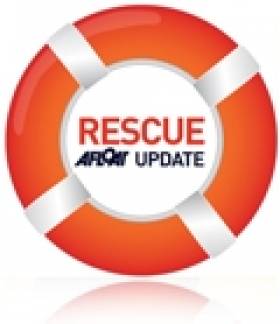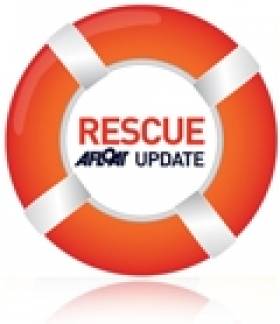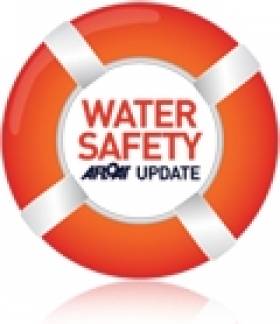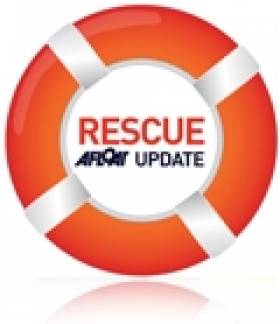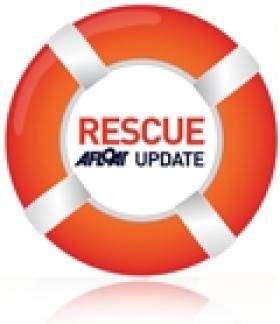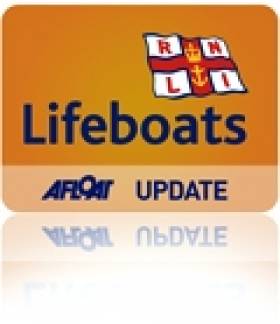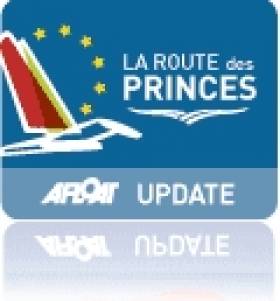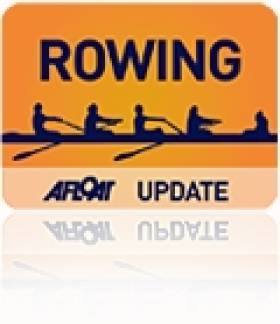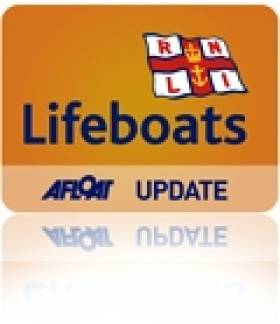Displaying items by tag: Rescue
Lifeguards Come To Seán Bán's Rescue in Coastal Drama
#Rescue - RTÉ's veteran voice of the Gaeltacht was rescued by beach lifeguards while swimming at Spanish Point in Co Clare earlier this week.
The Irish Independent reports that Seán Bán Breathnach was believed to be caught in a rip current while swimming at the popular seaside haunt on a break from broadcasting for Radio Na Gaeltachta in the area.
Speaking after, Breathnach put down the incident as "nothing really", saying he "wasn't out of my depth, I was just bobbing up and down".
Despite this, rip currents such as that he was caught in are never to be taken lightly - as last week's rescue of a family of six at Castlerock beach in Co Derry proves all too true.
And with the death toll from drownings around Ireland during this week's heatwave reaching five as of yesterday, the risks associated with the water are very real.
Elderly Woman Survives Fall From Europe's Highest Sea Cliff
#Rescue - An elderly woman was rescued on Thursday 11 July after slipping off the highest sea cliff in Europe.
The Belfast Telegraph reports that 71-year-old Vera Flynn became separated from her sister while walking the cliff path at Slieve League in Co Donegal.
According to the Donegal Democrat, it's believed she took a wrong turn on the path and slipped down the cliff face, becoming trapped in a ravine 400 metres from the top.
After a search lasting many hours, the woman was located by the Killybegs Coast Guard cliff rescue team and winched to safety, reportedly uninjured in her ordeal.
“There’s no doubt that this lady’s exceptional fitness helped her in this situation, given that she was out such a long time and it was such a hot day," said Killybegs coastguard press officer Shane McCrudden.
Roscommon Drowning Marks Fourth Tragedy In Two Days
#WaterSafety - RTÉ News reports that a teenager has drowned in Co Roscommon in the fourth such tragic incident during this week's heatwave.
The teen was one of three swimmers who went missing in Annaghmore Lough near Strokestown yesterday evening.
Two of the swimmers managed to reach the shore, but the body of this third was recovered before midnight by a search party led by the Irish Coast Guard's Shannon rescue helicopter and involving local angling boats.
The sad news comes just a day after a 12-year-old boy drowned while swimming in the sea off Youghal beach in Co Cork.
That followed the death of a 21-year-old woman named Lisa Knight who was swimming with friends in the River Feale in Co Limerick late on Tuesday night.
And on Wednesday afternoon a 17-year-old boy drowned after getting into difficulty swimming in a lake in Celbridge, Co Kildare, according to The Irish Times.
Irish Water Safety chief John Leech has appealed to the public on RTÉ Radio 1's Morning Ireland to be aware of the risks associated with the water, especially in unsupervised areas - and particularly for inexperienced swimmers.
#Rescue - Castlerock RNLI lifeguards rescued a family of six after they got into difficulty on the town’s seaside beach in Co Derry yesterday (7 July).
Senior RNLI lifeguard Gordon Clark was patrolling busy Castlerock beach when at he noticed a person in the water waving for help a short distance to the right of the flagged zone on the beach around 5.30pm.
The family of six – including a man, woman and four children – were all on bodyboards when they got caught in what appeared to be a flash rip, a strong current running out to sea.
After radioing for assistance, Clark swiftly entered the sea with a rescue tube. He was quickly joined in the rescue operation by his RNLI lifeguard colleagues Jenny Thompson and Ray Cunningham.
Clark and Thompson proceeded to safely ferry the children, followed by their parents, to the shore, where they were checked over to ensure they hadn’t taken on any water. All were safe and well.
Speaking following the rescue, Mike Grocott, RNLI lifeguard manager for Northern Ireland, said: "Rip currents often catch people out because they can be difficult to spot, and research shows that most people don’t know how to identify one. They are a major cause of incidents that the RNLI’s lifeguards deal with each season.
"Anyone who gets caught in a rip should try to remain calm, raise their arm in the air to signal for help like the family member did today. If they feel they can swim, they should swim parallel to the beach until free of the current, and then head for shore."
With temperatures expected to soar this week, Grocott reminded people to be mindful of the RNLI’s key safety recommendations – choose a lifeguarded beach and swim between the red and yellow flags, which mark the safest area to swim and are an indicator that lifeguards are on duty.
Teen Rescued From Howth Cliff Edge
#Rescue - TheJournal.ie reports that 15 members of the Irish Coast Guard's Cliff Rescue Unit were involved in the rescue of a 16-year-old boy trapped on a cliff edge on Howth Head in North Dublin on Saturday evening (6 July).
According to Howth Coast Guard, the teen had tried to climb up from the beach at Whitewater Brook but became stranded halfway up the cliff face.
Coastguard staff received the emergency call around 9.40pm and the rescue unit was on scene within 10 minutes. The teen was quickly recovered to the cliff top with no reported injuries.
Whitewater Brook was recently the scene of a joint cliff rescue training exercise involving the Howth Coast Guard and the Irish Red Cross.
New Emergency Info System Put Through Its Paces
#Rescue - The Irish Coast Guard and the RNLI were among the emergency services putting some new communication technology to the test last month.
As Phys.org reports, the emergency exercise in Malahide Estuary was designed to test the effectiveness of REACT, or Resource for Emergency services to Access Command and control data using satellite and hybrid Technologies.
The system, funded by the European Space Agency (ESA), employs satellite, mobile and other communications systems to maintain a constant open channel between different response services, even if one network goes down during a crisis.
Rescue teams in the field can also remain in two-way multimedia contact with co-ordinators in the control room to ensure the right people are where they need to be as quickly as possible.
Ritchie Hedderman, head of operations at the Dublin Fire Brigade, which also took part in the exercise, said: "In the event of a major emergency, secure and reliable communications are vital to the emergency services.
"I feel that the satellite communications in time will prove to be the primary and preferred means for communicating as it can supply voice, video and data back to regional and national control centres where strategic commanders can assess situation on the ground and provide the back up resources in order that a successful conclusion to the emergency can be obtained."
Phys.org has much more on the story HERE.
Skerries Lifeboat Rescues Colt Island Kayakers
#RNLI - Skerries RNLI rescued a group of teenagers who got into difficulty while kayaking on Sunday evening (30 June).
The volunteer crew launched their inshore lifeboat shortly after 6pm to reports of a group of kayakers on Colt Island who were unable to return to shore due to the deteriorating weather conditions.
Skerries RNLI lifeboat operations manager Niall McGrotty paged the crew after receiving information from a retired crew member that there was a group of kayakers stranded on Colt Island.
The lifeboat was helmed by Joe May and had crew members Philip Ferguson, David Knight and Adam Scott on board. Weather conditions at the time were a force five to six northerly wind and choppy seas.
Arriving on scene three minutes after launching, the lifeboat found 11 teenage boys with five kayaks sheltering on Colt Island, as they were unable to return to shore against the increasing wind and waves.
All 11 boys were taken on board the lifeboat and the five kayaks were taken in tow. The lifeboat towed the kayaks back to the slipway at the station where the volunteer shore crew recovered them. The lifeboat then brought the teenagers safely back to the harbour.
Speaking after the call-out, Skerries RNLI helm Joe May said: "The boys did the right thing in staying together, staying on the island and raising the alarm. If they had tried to make it back to shore we could have been dealing with a much more serious situation.
"Our volunteer crew are always ready to respond to any emergency and we were happy to bring everyone safely home."
#Spindrift - The race-winning multihull Spindrift has capsized in gale force winds off Dun Laoghaire this afternoon (22 June) at the start of the Route des Princes series of inshore racing spectacle on Dublin Bay, as David O'Brien reports on scene.
The MOD70 trimaran that was first into Dun Laoghaire from Lisbon on Wednesday capsized meres from spectators in Scotsman's Bay ahead of the first of three inshore races.
Rescue photos below.
The accident happened about 700 metres off the starting line in the first race, as the boats were accelerating in the strong and gusty winds. The boats were not carrying full sail as a precaution against the strong offshore winds blowing in the bay. Today's in–port racing was billed as 'fast and furious'.
At least one person is injured and is being treated upturned hull of the stricken craft. As of 3.08pm a rescue helicopter was dropping its winchman to the vessel.
It is feared by National Yacht Club personnel that the mast of the inverted trimaran is stuck in the sea bed and may be broken.
All racing has now been postponed as rescue services attended the scene. Eight crew were onboard the vessel at the time of the capsize.
Update 3.10pm: All other boats have returned to Dun Laoghaire Harbour as rescue services continue to attend to the capsized Spindrift and its crew.
Update 3.18pm: Weather conditions in Dun Laoghaire continue to be strong and gusty, and it's reported that some local DBSC RC racing had already been cancelled earlier today.
Update 3.27pm: A news update on the Route des Princes website (via @sailracewin) says one crewman on the upturned Spindrift has a back pain.
Update 3.35pm: Twitter users Mark Lloyd (@Lloyd_Images) and Philip Bromwell (@philipbromwell) have posted photos of the failed Spindrift in Dublin Bay as emergency services attend to the scene.
Update 3.39pm: The crewman casualty has been winched to the helicopter and is being airlifted to Tallaght Hospital. His condition remains unclear.
Update 3.41pm: Triage for any injured racers has been set up at the National Yacht Club and all rescue boats have been asked to report to the NYC to account for numbers.
Update 3.53pm: Assessments are currently being made as to how to recover the 70ft hull still floating north of Dalkey Island.
Update 4.04pm: Sailing journalist Kate Laven comments on Twitter re the Spindrift capsize: "Everyone recovered but two injured"
Update 4.08pm: The Route des Princes website has followed up its earlier update with a news post which confirms that weather conditions at the time of the Spindrift capsize were 20 knots with strong gusts.
Update 4.55pm: Dun Laoghaire lifeboat towing the upturned Spindrift hull (minus mast) towards Dun Laoghaire harbour
Update 6,00pm: The upturned hull has been successfully righted, the hull is intact but the mast is broken.
Update 7.00pm: There are unconfirmed reports that the injury to the Spindrift crew man is a broken pelvis.
Update 8.00pm: Spindrift racing team release statement on capsize and injury to crew member
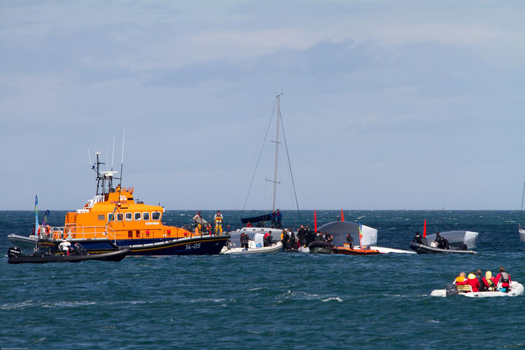
Rescue craft, local boats and the Dun Laoghaire lifeboat attend the upturned hull. Photo: Gareth Craig

The Coastguard helicopter arrives on scene and a winch man is lowered to make an assessment. Photo: Afloat.ie

Rescue personnel and Sprindrift crew on the upturned hull in Dublin Bay this afternoon. Photo: Afloat.ie
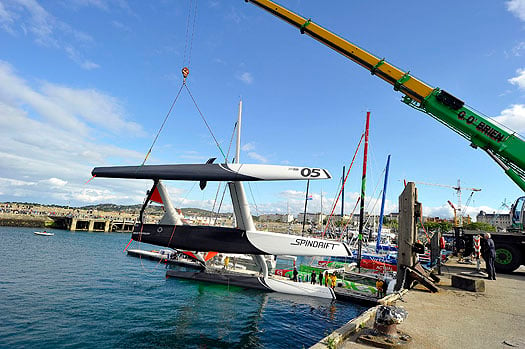
Spindrift minus her mast is lifted in Dun Laoghaire harbour this evening. Photo: Michael Chester
Rowers Rescued After Fisa Tour Hit by Squall on Shannon
# ROWING RESCUE: The Fisa Rowing Tour on the Shannon has been suspended a day before the scheduled finish after a number of boats were swamped during a squall on Lough Derg. Fourteen boats, which take a crew of five, were on the water at the time. All the rowers were accounted for and though some rowers were treated for hypothermia, none needed to go to hospital.
The full number on the tour, which is popular with retired people, was 101, but 31 had either taken the day off or were cycling alongside the Shannon.
The organisers were surprised to hear reports that 18 boats were “capsized” and that rowers did not have life jackets. “All rowers were wearing lifejackets or had access to them,” one of the main support personnel said. For a time one boat was thought to be missing, but the rowers were on land.
Larne RNLI Rescues Unconscious Man From Lough
#RNLI - Larne RNLI rescued an unconscious man who was found a short distance from the shore at Larne Lough last night (Thursday 20 June).
The volunteer crew launched their inshore lifeboat Hannahbella Ferguson following a request by Belfast Coastguard at 10.35pm to go to the assistance of a person who was spotted lying face down in the sea within 200 metres from the shore in Larne Lough.
Weather conditions at the time were good with a flat calm sea but light was fading.
The lifeboat - helmed by Willie Evans and with crew members Dave Somerville and Pamela Dorman onboard - arrived on scene at 10.41pm and pulled the casualty on to the lifeboat. With the man not breathing, two crew members proceeded to perform CPR and resuscitated the casualty.
The helm brought the lifeboat into a small slipway along the promenade which was accessible due to a high tide. The casualty was subsequently handed over to the waiting paramedics and ambulance.
Speaking after the call-out, Larne RNLI helm Willie Evans praised the crew who he said had worked together to resuscitate the casualty and bring him to shore.





























